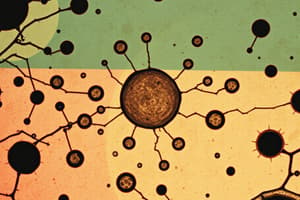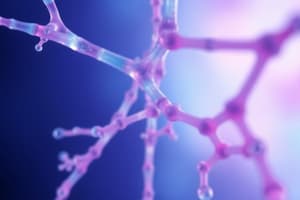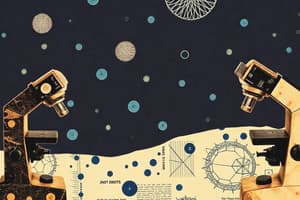Podcast
Questions and Answers
What is a fundamental aspect of the modern cell theory?
What is a fundamental aspect of the modern cell theory?
- All cells contain DNA.
- All cells arise from other cells. (correct)
- All organisms are unicellular.
- All life functions occur outside cells.
Which statement correctly differentiates prokaryotic cells from eukaryotic cells?
Which statement correctly differentiates prokaryotic cells from eukaryotic cells?
- Eukaryotic cells lack a cell wall.
- Eukaryotic cells are generally smaller than prokaryotic cells.
- Prokaryotic DNA is circular without proteins. (correct)
- Prokaryotic cells have a membrane-bound nucleus.
Which organisms are categorized as prokaryotes?
Which organisms are categorized as prokaryotes?
- Bacteria (correct)
- Plants
- Humans
- Fungi
What observation did Rudolf Virchow contribute to the cell theory?
What observation did Rudolf Virchow contribute to the cell theory?
Which of the following is a characteristic of eukaryotic cells?
Which of the following is a characteristic of eukaryotic cells?
What is the size comparison between prokaryotic and eukaryotic cells?
What is the size comparison between prokaryotic and eukaryotic cells?
Which of the following statements about prokaryotes is true?
Which of the following statements about prokaryotes is true?
Which of the following statements is NOT part of the modern cell theory?
Which of the following statements is NOT part of the modern cell theory?
What type of cells are formed through the union of male and female gametes?
What type of cells are formed through the union of male and female gametes?
Which statement correctly describes the difference between somatic cells and germ cells?
Which statement correctly describes the difference between somatic cells and germ cells?
In a multicellular organism, which of the following statements is true regarding germ cells?
In a multicellular organism, which of the following statements is true regarding germ cells?
Which statement best describes the chromosome composition in diploid somatic cells?
Which statement best describes the chromosome composition in diploid somatic cells?
What is the primary difference in chromosome structure between haploid and diploid cells?
What is the primary difference in chromosome structure between haploid and diploid cells?
What term refers to the smallest basic unit forming living organisms?
What term refers to the smallest basic unit forming living organisms?
Who was the first person to observe living sperm cells?
Who was the first person to observe living sperm cells?
Which scientist is credited with the first use of the term 'cell'?
Which scientist is credited with the first use of the term 'cell'?
What significant structure did Robert Brown discover in 1833?
What significant structure did Robert Brown discover in 1833?
Which statement is true regarding the cell theory contributors?
Which statement is true regarding the cell theory contributors?
What was a notable advantage of Antony van Leeuwenhoek's microscopes?
What was a notable advantage of Antony van Leeuwenhoek's microscopes?
Which of the following statements about cell biology is accurate?
Which of the following statements about cell biology is accurate?
In what year did Matthias Schleiden conclude that all plants are composed of cells?
In what year did Matthias Schleiden conclude that all plants are composed of cells?
What is the main difference in the DNA structure between prokaryotes and eukaryotes?
What is the main difference in the DNA structure between prokaryotes and eukaryotes?
Which of the following statements is true about binary fission?
Which of the following statements is true about binary fission?
What happens during the process of sporulation in bacteria?
What happens during the process of sporulation in bacteria?
Which type of organism primarily reproduces through binary fission?
Which type of organism primarily reproduces through binary fission?
Which statement accurately describes the cell wall of eukaryotic organisms?
Which statement accurately describes the cell wall of eukaryotic organisms?
What is the primary method of reproduction in multicellular organisms?
What is the primary method of reproduction in multicellular organisms?
During which condition do bacteria form endospores?
During which condition do bacteria form endospores?
What type of organism is excluded from being classified as prokaryotes?
What type of organism is excluded from being classified as prokaryotes?
Flashcards are hidden until you start studying
Study Notes
Cell Biology
- Cell biology studies cell structure, function, growth, reproduction, and genetics.
- The cell is the fundamental building block of life, forming the basis of all organisms.
- Organisms can be unicellular (single-celled), like bacteria, or multicellular (composed of many cells), like humans.
History of Cell Discovery
- Hans and Zacharias Jansen (1595): Developed the compound microscope, a crucial tool for observing microscopic structures.
- Robert Hooke (1665): First used the term "cell" after observing box-like compartments in cork under a microscope.
- Antony van Leeuwenhoek (1670s): Utilized microscopes to observe various microbes and body cells, including blood cells and sperm cells, significantly expanding our understanding of microscopic life.
- Robert Brown (1833): Discovered the nucleus in plant cells, a key component of cell structure and function.
- Matthias Schleiden (1838): Determined that all plants are composed of cells.
- Theodor Schwann (1839): Established that all animal tissues are made up of cells, contributing to the foundation of cell theory.
- Rudolf Virchow (1858): Completed the cell theory by stating that all living things arise from pre-existing cells, highlighting the importance of cell division in life.
Cell Theory
- All organisms are composed of one or more cells.
- All life functions take place within cells.
- All cells arise from pre-existing cells.
Prokaryotes vs. Eukaryotes
- Prokaryotes: Organisms lacking a membrane-bound nucleus and other internal membrane-bound organelles. They include bacteria and blue-green algae.
- Eukaryotes: Organisms with a membrane-bound nucleus and other internal membrane-bound organelles. They include plants, fungi, animals, and humans.
Key Differences Between Prokaryotes and Eukaryotes
- Size: Prokaryotes are smaller than eukaryotes.
- Structure: Prokaryotes have a simpler structure than eukaryotes.
- Reproduction: Prokaryotes reproduce more rapidly than eukaryotes.
- Nucleus: Prokaryotes lack a membrane-bound nucleus, while eukaryotes have a well-defined nucleus.
- DNA: Prokaryotic DNA is circular and not associated with proteins, while eukaryotic DNA is linear and associated with proteins.
- Cell Wall: Prokaryotes have a cell wall, while only plant and fungal cells have a cell wall. Animal cells have a cell membrane.
Bacteria
- Bacteria are the smallest and most basic microorganisms, classified as prokaryotes.
- Antony van Leeuwenhoek was the first scientist to observe bacteria.
Reproduction in Bacteria
- Binary fission: The primary method of reproduction in bacteria. It involves a single cell dividing into two identical daughter cells. This process occurs during favorable conditions.
- Endospore formation: A form of reproduction that occurs under unfavorable conditions like environmental stress. A bacterial cell becomes a dormant spore, resistant to harsh conditions like heat, radiation, and disinfectants. Endospores can survive for long periods, allowing bacteria to remain viable until favorable conditions return.
Sexual Reproduction in Eukaryotes
- Multicellular organisms reproduce sexually, involving the fusion of male and female gametes (ova and sperms) to form a zygote, which develops into a new individual.
Somatic Cells and Germ Cells
- Somatic cells: Make up the body of an organism.
- Germ cells (gametes): Involved in sexual reproduction and are haploid, containing one set of chromosomes.
Haploid and Diploid Cells
- Haploid cells: Contain one set of chromosomes (N).
- Diploid cells: Contain two sets of chromosomes (2N). Germ cells are haploid, while somatic cells are diploid.
Studying That Suits You
Use AI to generate personalized quizzes and flashcards to suit your learning preferences.




